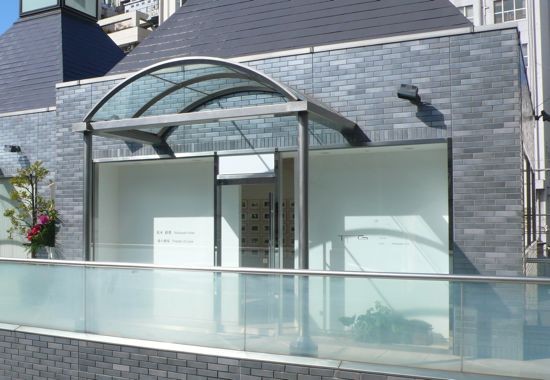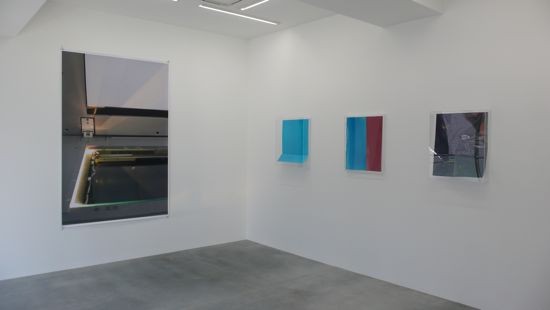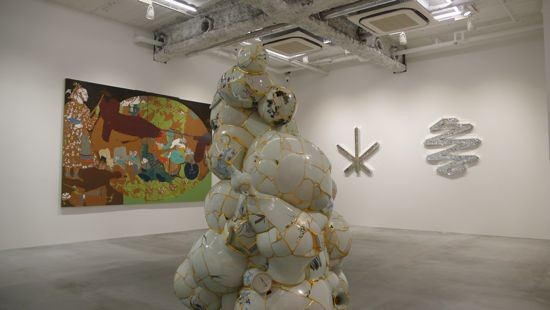
Exterior view of Taka Ishii Gallery Photography/Film’s bungalow-style space at Piramide Building complex, Roppongi, 2011. Photo ART iT.
Since the rise of a new generation of contemporary art dealers in the 1990s, Tokyo has become famous for its itinerant galleries criss-crossing the city every few years. The latest reshuffling of the Tokyo art map takes effect Feb 18 when a group of four galleries move into new spaces in the Piramide Building in the shadow of the Roppongi Hills lifestyle and office development. A multi-story dining and retail complex, the Piramide Building will now accommodate leading galleries Ota Fine Arts and Wako Works of Art, a branch of Taka Ishii Gallery dedicated to photography and film and Zen Foto.
The move makes sense for Ota, previously located in the industrial Kachidoki area, and for Wako, arriving from the fringes of Shinjuku. Both galleries deal with blue-chip artists such as Yayoi Kusama and Gerhard Richter, respectively, but both had been somewhat inconvenient to the rest of the city’s gallery scene, which in recent years has evolved along an axis that roughly follows the subway Oedo line running from Kiyosumi-Shirakawa station at one extreme to neighboring stops Azabu-Juban and Roppongi at the other. Kiyosumi-Shirakawa is home to both the Kiyosumi warehouse complex of top galleries and the Museum of Contemporary Art, Tokyo, while Roppongi is proximal to the Mori Art Museum and galleries including Side 2, Take Ninagawa and a building in Shirokane with Kodama, Yamamoto Gendai and Nanzuka Underground galleries. Also setting up shop in Shirokane in late 2010 was Misa Shin Gallery, whose namesake owner is the former director of Art Fair Tokyo.


Top: Installation view of works by Wolfgang Tillmans in the exhibition “New Space, New Works” at Wako Works of Art in the Piramide Building complex, Roppongi, 2011. Bottom: Installation view of works in the exhibition “New Address, New Works” at Ota Fine Arts in the Piramide Building complex, Roppongi, 2011. Both: Photo ART iT.
The Piramide Building reinserts Ota and Wako into the heart of this axis and provides a central outpost for Taka Ishii, which is headquartered in Kiyosumi. It also boosts the area’s market wattage. Wako opens with a group show, “New Space, New Works,” with new works by artists including Wolfgang Tillmans, Gerhard Richter and Fiona Tan, while Ota’s similarly themed “New Address, New Works” seeks to tap into the regional market for the Asian Contemporary Art genre with Indonesian Ay Tjoe Christine, Iranian Monir Farmanfarmaian and Korean Yee Kookyung, and Taka Ishii opens with a solo show for legendary photographer Nobuyoshi Araki.
This latest move is in fact a re-consolidation of Roppongi as art hub and a return of sorts, as from 2003 to 2008 the neighborhood had been home to an art-focused building, known simply as Complex, run by the same Mori Building Co that developed Roppongi Hills. After Mori decided not to renew the gallery leases, tenants including Ota Fine Arts were forced to seek new lodgings. While Ota went to Kachidoki, former co-tenants Taro Nasu and Roentgenwerke moved to the Bakurocho area, where they now form the core of an emerging gallery hub there. Almost three years on, the Complex building remains empty and shuttered.
“New Space, New Works” continues at Wako Works of Art through March 26; “New Address, New Works” continues at Ota Fine Arts through April 1; Nobuyoshi Araki continues at Taka Ishii Gallery Photography/Film through March 26.
Related:
– New ‘Concept’ Fair Debuts in Tokyo
– Tokyo’s ‘Yebizo’ media arts festival unveils 3rd edition
– G-tokyo returns for second edition
